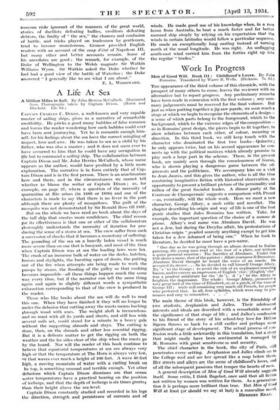A Life At Sea
CAPTAIN CHARLES C. DIXON, a well-known and very capable master of sailing ships, gives us a narrative of remarkable credibility. He pricks a good many bubbles of false romance and leaves the reader wondering how such bubbles could ever have been sent journeying. Yet he is romantic enough him- self, for his feelings about the sea have the correct mingling of respect, love and awe. He was taken to sea as a child by his father, who was also a master ; and it does not seem ever to have occurred to him that he could have any occupation in life but to command a sailind Ship. The collaboration between Captain Dixon and Mr. John Herries McCulloch, whose name appears as the author, would have profited by a little more explanation. The narrative is in form entirely that of Cap. tam n Dixon and is in the first person. There is an anachronism here and there, and in the circumstances we cannot tell whether to blame the writer or Captain Dixon ; as, for example, on page 37, where a question of the necessity of quarantine at Rio arises (in 1889 or 1890) and one of the characters is made to say that there is no fever in the port although there are plenty of mosquitoes. The guilt of the mosquito was not demonstrated by Sir Ronald Ross till 1897.
But on the whole we have read no book about the days of the tall ship that creates more confidence. The chief reason for its effectiveness is that one or other of the collaborators thoroughly understands the necessity of iteration for pro- ducing the sense of a storm at sea. The crew suffer from such a succession of shocks that it becomes a monotony of suffering. The pounding of the sea on a heavily laden vessel is much more severe than on one that is buoyant, and most of the time when Captain Dixon was at sea the loading laws were lax. The crash of an immense bulk of water on the decks, hatches, houses and skylights, the bursting open of doors, the putting out of the fire when attempts are being made to work the pumps by steam, the flooding of the galley so that cooking becomes impossible—all these things happen much the same way every time, but if the narrator can tell the same thing again and again in slightly different words a sympathetic exhaustion corresponding to that of the crew is produced in the reader.
Those who like books about the sea will do well to read this one. When they have finished it they will no longer be under the delusion that cutting away the masts means hacking through wood with axes. The weight aloft is tremendous, and no mast with all its yards and sheets, and still less with several sails set, could stand for a minute in a heavy gale without the supporting shrouds and stays. The cutting is done, then, on the shrouds and other less essential rigging.
But it is a delicate matter to get the rigging on both the weather and the lee sides clear of the ship when the masts go by the board. Nor will the reader of this book continue to believe that equatorial temperatures at sea are always very high or that the temperature at The Horn is always very low, or that waves ever reach a height of 100 feet. A wave 40 feet high, a moving mountain of water with a curling break on he top, is something unusual and terrible enough. Yet other delusions which Captain Dixon dismisses are that ocean water temperatures have a practical bearing on the position of icebergs, and that the depth of icebergs is six times greater than their height above the sea-level.
Captain Dixon constantly studied and recorded in his logs the direction, strength and persistence of currents and of
winds. He made good use of his knowledge when, in a race home from Australia, he beat a much faster and far better manned ship simply by relying on his expectation that the winds in certain latitudes would follow a particular sequence. He made an exceptionally long casting instead of turning north at the usual longitude. He was right. An unflagging south-east wind carried him from the forties right up into the regular "trades."
















































 Previous page
Previous page